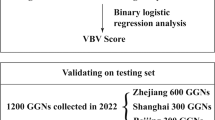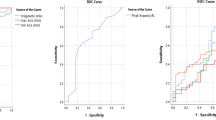Abstract
Objective
To investigate the relationships between pulmonary ground-glass nodules (GGN) and blood vessels and their diagnostic values in differentiating GGNs.
Methods
Multi-detector spiral CT imaging of 108 GGNs was retrospectively reviewed. The spatial relationships between GGNs and supplying blood vessels were categorized into four types: I, vessels passing by GGNs; II, intact vessels passing through GGNs; III, distorted, dilated or tortuous vessels seen within GGNs; IV, more complicated vasculature other than described above. Relationship types were correlated to pathologic and/or clinical findings of GGNs.
Results
Of 108 GGNs, 10 were benign, 24 preinvasive nodules and 74 adenocarcinomas that were pathologically proven. Types I, II, III and IV vascular relationships were observed in 9, 58, 21 and 20 GGNs, respectively. Type II relationship was the dominating relationship for each GGN group, but significant differences were shown among them. Correlation analysis showed strong correlation between invasive adenocarcinoma and type III and IV relationships. Subgroup analysis indicated that type III was more commonly seen in IAC with comparison to type IV more likely seen in MIA.
Conclusion
Different GGNs have different relationships with vessels. Understanding and recognising characteristic GGN-vessel relationships may help identify which GGNs are more likely to be malignant.
Key Points
• Multi-detector CT offers new information about ground-glass nodules
• In particular we can now study their relationship with vessels
• Different types of ground-glass nodules have different relationships with vessels
• This may help identify which ground-glass nodules are likely to be malignant




Similar content being viewed by others
References
Tammemagi MC, Katki HA, Hocking WG et al (2013) Selection criteria for lung-cancer screening. N Engl J Med 368:728–736
Henschke CI, Yankelevitz DF, Mirtcheva R et al (2002) CT screening for lung cancer: frequency and significance of part-solid and nonsolid nodules. AJR Am J Roentgenol 178:1053–1057
Mori K, Saitou Y, Tominaga K et al (1990) Small nodular lesions in the lung periphery: new approach to diagnosis with CT. Radiology 177:843–849
Mihara N, Kuriyama K, Kido S et al (1998) The usefulness of fractal geometry for the diagnosis of small peripheral lung tumors. Nihon Igaku Hoshasen Gakkai Zasshi 58:148–151
Choi JA, Kim JH, Hong KT et al (2000) CT bronchus sign in malignant solitary pulmonary lesions: value in the prediction of cell type. Eur Radiol 10:1304–1309
Yabuuchi H, Murayama S, Sakai S et al (1999) Resected peripheral small cell carcinoma of the lung: computed tomographic-histologic correlation. J Thorac Imaging 14:105–108
Kim HY, Shim YM, Lee KS et al (2007) Persistent pulmonary nodular ground-glass opacity at thin-section CT: histopathologic comparisons. Radiology 245:267–275
Ko JP (2005) Lung nodule detection and characterization with multi-slice CT. J Thorac Imaging 20:196–209
Aoki T, Tomoda Y, Watanabe H et al (2001) Peripheral lung adenocarcinoma: correlation of thin-section CT findings with histologic prognostic factors and survival. Radiology 220:803–809
Travis WD, Brambilla E, Noguchi M et al (2011) International association for the study of lung cancer/American thoracic society/European respiratory society international multidisciplinary classification of lung adenocarcinoma. J Thorac Oncol 6:244–285
Henschke CI, Yankelevitz DF, Naidich DP et al (2004) CT screening for lung cancer: suspiciousness of nodules according to size on baseline scans. Radiology 231:164–168
Midthun DE, Swensen SJ, Jett J et al (2003) Evaluation of nodules detected by screening for lung cancer with low dose spiral computed tomography. Lung Cancer 41:S40
MacMahon H, Austin JH, Gamsu G et al (2005) Fleischner society. Guidelines for management of small pulmonary nodules detected on CT scans: a statement from the fleischner society. Radiology 237:395–400
Takashima S, Maruyama Y, Hasegawa M et al (2003) CT findings and progression of small peripheral lung neoplasms having a replacement growth pattern. Am J Roentgenol 180:817–826
Nambu A, Araki T, Taguchi Y et al (2005) Focal area of ground-glass opacity and ground-glass opacity predominance on thin-section CT: discrimination between neoplastic and non-neoplastic lesions. Clin Radiol 60:1006–1017
Tsutsui S, Ashizawa K, Minami K et al (2010) Multiple focal pure ground-glass opacities on high-resolution CT images: Clinical significance in patients with lung cancer. Am J Roentgenol 195:W131–W138
Naidich DP, Bankier AA, MacMahon H et al (2013) Recommendations for the management of subsolid pulmonary nodules detected at CT: a statement from the Fleischner Society. Radiology 266:304–317
National Comprehensive Cancer Network (2011) NCCN clinical practice guidelines in oncology: Non-small cell lung cancer. V.2.2010. 2011
Soda H, Nakamura Y, Nakatomi K et al (2008) Stepwise progression from ground-glass opacity towards invasive adenocarcinoma: long-term follow-up of radiological findings. Lung Cancer 60:298–301
Lee HJ, Goo JM, Lee CH et al (2007) Nodular ground-glass opacities on thin-section CT: size change during follow-up and pathological results. Korean J Radiol 8:22–31
Noguchi M, Morikawa A, Kawasaki M et al (1995) Small adenocarcinoma of the lung. Histologic characteristics and prognosis. Cancer 75:2844–2852
Zwirewich CV, Vedal S, Miller RR et al (1991) Solitary pulmonary nodule: high-resolution CT and radiologic-pathologic correlation. Radiology 179:469–476
Folkman J (1995) Angiogenesis in cancer, vascular, rheumatoid and other disease. Nat Med 1:27–31
Fridman WH, Dieu-Nosjean MC, Pages F, et al. (2012) The immune microenvironment of human tumors: general significance and clinical impact. Cancer Microenviron
Fontanini G, Vignati S, Boldrini L et al (1997) Vascular endothelial growth factor is associated with neovascularization and influences progression of non-small cell lung carcinoma. Clin Cancer Res 3:861–865
Yang CF, Yasukawa T, Kimura H et al (2000) Experimental corneal neovascularization by basic fibroblast growth factor incorporated into gelatin hydrogel. Ophthalmic Res 32:19–24
Max R, Gerritsen RR, Nooijen PT et al (1997) Immunohistochemical analysis of integrin alpha vbeta3 expression on tumor-associated vessels of human carcinomas. Int J Cancer 71:320–324
Yang Z, Sone S, Takashima S et al (1999) Small peripheral carcinomas of the lung: thin-section CT and pathologic correlation. Eur Radiol 9:1819–1825
Kakinuma R, Ohmatsu H, Kaneko M et al (1999) Detection failures in spiral CT screening for lung cancer: analysis of CT findings. Radiology 212:61–66
de Hoop B, Gietema H, van de Vorst S et al (2010) Pulmonary ground-glass nodules: increase in mass as an early indicator of growth. Radiology 255:199–206
Acknowledgement
Feng Gao and Ming Li contributed equally to this article.
This study was partly financially supported by the Science and Technology Commission Foundation of Shanghai (no. 10411952600, 124119a0400) and the Young Investigator Fund of Fudan University (grant no. EYF163006).
Author information
Authors and Affiliations
Corresponding authors
Rights and permissions
About this article
Cite this article
Gao, F., Li, M., Ge, X. et al. Multi-detector spiral CT study of the relationships between pulmonary ground-glass nodules and blood vessels. Eur Radiol 23, 3271–3277 (2013). https://doi.org/10.1007/s00330-013-2954-3
Received:
Revised:
Accepted:
Published:
Issue Date:
DOI: https://doi.org/10.1007/s00330-013-2954-3




